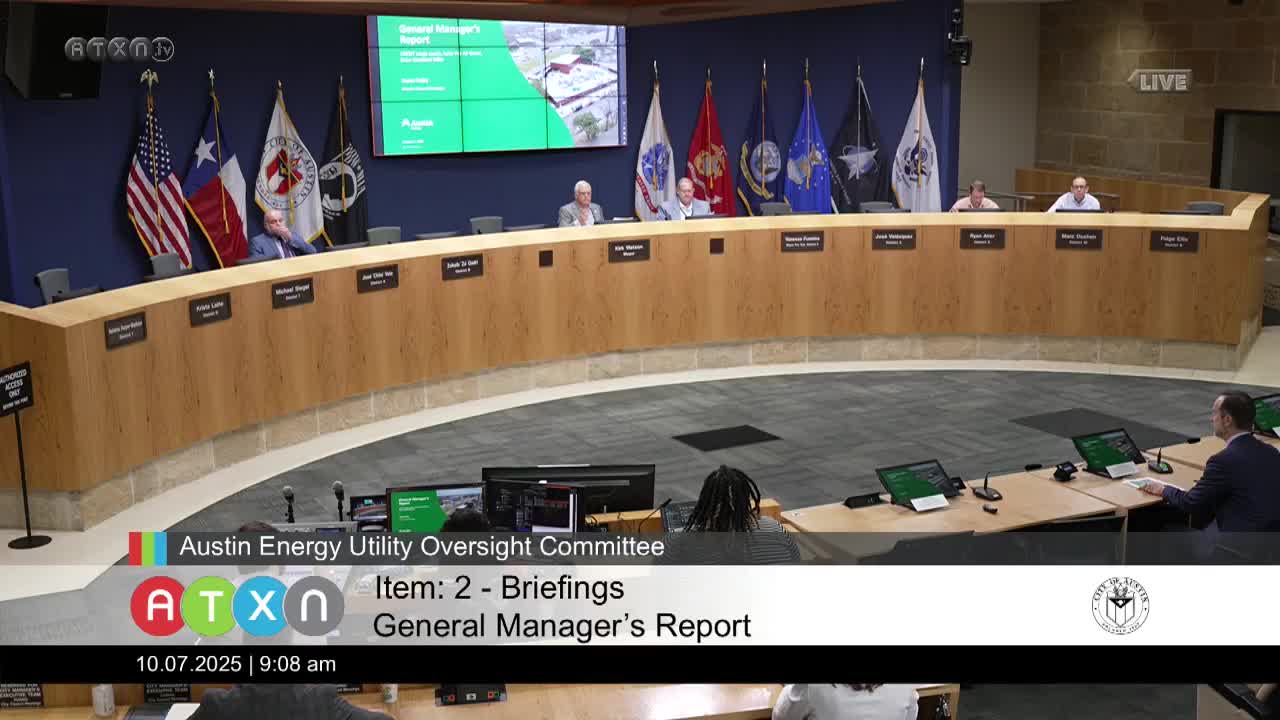Austin Energy warns rapid ‘large load’ growth will test transmission, generation and equipment supply
October 07, 2025 | Austin, Travis County, Texas
This article was created by AI summarizing key points discussed. AI makes mistakes, so for full details and context, please refer to the video of the full meeting. Please report any errors so we can fix them. Report an error »

Austin Energy staff told the Utility Oversight Committee on Oct. 7 that a surge in “large loads” — customers such as data centers, industrial facilities and hydrogen or crypto operations — is changing planning and could strain transmission, generation and equipment supply chains.
Interim General Manager Stuart Riley briefed the committee on ERCOT forecasts and local requests, noting ERCOT’s adjusted load forecast shows 87 gigawatts in 2025 and, after adjustments, about 145 gigawatts of likely demand growth vs. a raw figure near 218 gigawatts. Riley said the adjusted forecast implies a roughly 67% increase in ERCOT demand over six years and described that increase as the equivalent of “adding more than 19 Austins” to the grid.
That scale of growth raises three linked problems, Riley said: transmission capacity and congestion where upgrades are needed; long lead times for grid-scale equipment (substation transformers, circuit breakers and other gear); and the time needed to site and construct new generation and transmission. “These customers want to be able to come online within one to two years,” Riley said. “But the regulatory process, the construction process, the supply chain… is really taking three to five years, probably closer to the five year aspect.”
Riley noted Senate Bill 6 (2023 Texas Legislature) set a 75-megawatt threshold that directs very large load requests into the ERCOT planning process; in practice, he said, some customers have sized down below that threshold and left the interconnection decision to local utilities.
Committee members pressed staff on implications for Austin. Riley said Austin’s service territory is relatively compact and that the utility has received interest that, if characterized by likelihood, totals roughly 500 megawatts. He emphasized the local planning tradeoffs: adding large, high-load customers can increase utility revenue and lower per-customer fixed costs, but only if transmission and generation are available to serve them without creating excessive scarcity or stranded investments.
Council members discussed whether to pursue targeted economic development that accounts for a customer’s ability to be curtailable or to provide on-site generation. Riley said some research-and-development data centers with flat, high load factors can be curtailable and that staff are exploring demand-response and on-site generation options in their negotiations.
Committee members also raised equipment lead times for new peaking units and other capacity additions. Riley said industry queues for peaker units and similar resources now run roughly three to five years, and that utilities are making early deposits to reserve manufacturing slots.
The committee did not take formal action on large-load interconnection policy at this meeting; members requested continued updates as Austin Energy advances transmission import capability, generation adequacy planning and customer-specific risk assessments.
Interim General Manager Stuart Riley briefed the committee on ERCOT forecasts and local requests, noting ERCOT’s adjusted load forecast shows 87 gigawatts in 2025 and, after adjustments, about 145 gigawatts of likely demand growth vs. a raw figure near 218 gigawatts. Riley said the adjusted forecast implies a roughly 67% increase in ERCOT demand over six years and described that increase as the equivalent of “adding more than 19 Austins” to the grid.
That scale of growth raises three linked problems, Riley said: transmission capacity and congestion where upgrades are needed; long lead times for grid-scale equipment (substation transformers, circuit breakers and other gear); and the time needed to site and construct new generation and transmission. “These customers want to be able to come online within one to two years,” Riley said. “But the regulatory process, the construction process, the supply chain… is really taking three to five years, probably closer to the five year aspect.”
Riley noted Senate Bill 6 (2023 Texas Legislature) set a 75-megawatt threshold that directs very large load requests into the ERCOT planning process; in practice, he said, some customers have sized down below that threshold and left the interconnection decision to local utilities.
Committee members pressed staff on implications for Austin. Riley said Austin’s service territory is relatively compact and that the utility has received interest that, if characterized by likelihood, totals roughly 500 megawatts. He emphasized the local planning tradeoffs: adding large, high-load customers can increase utility revenue and lower per-customer fixed costs, but only if transmission and generation are available to serve them without creating excessive scarcity or stranded investments.
Council members discussed whether to pursue targeted economic development that accounts for a customer’s ability to be curtailable or to provide on-site generation. Riley said some research-and-development data centers with flat, high load factors can be curtailable and that staff are exploring demand-response and on-site generation options in their negotiations.
Committee members also raised equipment lead times for new peaking units and other capacity additions. Riley said industry queues for peaker units and similar resources now run roughly three to five years, and that utilities are making early deposits to reserve manufacturing slots.
The committee did not take formal action on large-load interconnection policy at this meeting; members requested continued updates as Austin Energy advances transmission import capability, generation adequacy planning and customer-specific risk assessments.
View full meeting
This article is based on a recent meeting—watch the full video and explore the complete transcript for deeper insights into the discussion.
View full meeting
